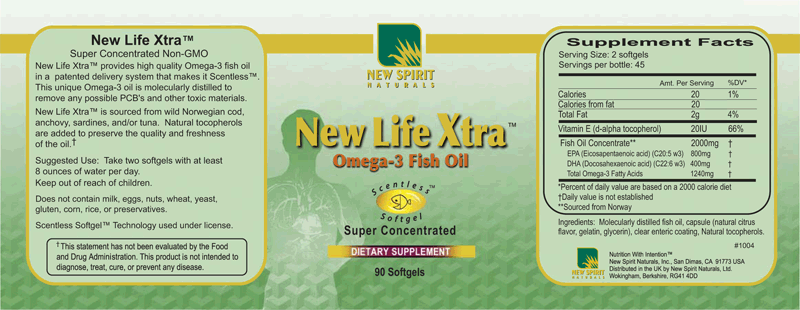
New Life Extra
A rich source of the
essential fatty acid Omega 3
When regularly consumed, Omega 3 fatty acids dramatically reduce harmful cholesterol and triglyceride levels.
| 90 softgels Retail $34.95 / Your Cost$26.21 |



Fish oil contains the essential fats EPA & DHA for great skin, exceptional brain function, and to prevent and minimize inflammation, a key component of many degenerative disease processes.
New Life Xtra provides a rich source of Omega 3 Fatty Acids (Essential Fatty Acids EPA & DHA) derived from deep cold water fish.
While saturated or hydrogenated fats should be avoided, essential fatty acids supply the body with important metabolic building blocks. Improving the ratio of Omega 3 to Omega 6 in the diet has been shown to play a crucial role in prostaglandin production. Prostaglandins play an important role in virtually every major body function, including blood pressure, fluid retention, blood cell stickiness, inflammation, allergies, fever and the immune system.
Research in the American Journal of Health System Pharmacy suggests 2 to 4 grams of fish oil per day as an important dietary element for:
New Life Extra™ is a pharmaceutical grade, molecularly distilled Omega-3 fish oil that has been rigorously tested and certified free of harmful environmental contaminants, including mercury, lead, arsenic, pesticides, PCB, and dioxins. These cutting edge tests can also predict possible rancidity, a factor that determines the flavor and aroma of the product.
New Life Extra™ is so pure and fresh that it can be used directly from the bottle or mixed with food, on salads or in smoothies.
Each softgel contains EPA (400mg) & DHA (200 mg) PLUS other Omega-3.
Each softgel capsule has an enteric lining, providing a product that has no odor and no after taste or repeat.
Omega-3 fatty acids were discovered by researchers studying the Eskimos is Greenland. Noting that these people rarely suffered from heart disease or atherosclerosis desipte their high consumption of fat and protein, the researchers now credit this to the Omega-3 found in the deep cold water fish. In contrast to the Eskimo diet, the average diet contains very low levels of Omega-3 fatty acids.
Low fat has become the standard for selecting food for a healthy diet. But the general public is often confused or misinformed about the effects - positive and negative - of fats and oils (collectively referred to as lipids).
Despite sometimes conflicting data, the evidence is mounting showing a direct relationship between the typical high-fat Standard American Diet (the SAD diet) and the major degenerative diseases of our time such as cancer and heart disease.
There is now direct evidence that excessive dietary fat may well function as a carcinogen.1 However, fats (lipids) are needed in our diet. They serve as the most efficient source of calories(9 per gram) and are essential to many body functions, particularly the production of hormones. The real question is how much fat (lipids) and what kind of fat do we need?
Dietary studies suggest that the most likely protective benefit of a low fat diet does not begin to appear until the fat content of the diet dips below 25% of total calories. Other studies indicate that it is not just the amount of fat, but the type of fat that we consume that is linked to cancer and heart disease. Omega 3 oil. Linoleic Acid's first double bond is at the sixth carbon. Thus, it is referred to as an Omega 6 oil. Due to these distinct differences, Linoleic Acid and Alpha-Linolenic Acid form entirely different prostaglandins. A deficiency in either Essential Fatty Acid is associated with decreased synthesis of anti-inflammatory prostaglandins.
Many of the beneficial effects of chosing a diet rich in plant foods are the result of the low levels of saturated fat and the relatively higher levels of essential fatty acids.
Now there is increasing evidence that the ratio of Omega 3 to Omega 6 in the diet can play a crucial role in the development of many degenerative diseases. Dr. Rashda Karmali of the Memorial Sloan-Kettering Cancer Center in New York is one of the leaders in the study of the relationship between the essential fatty acids and cancer. At a NATO Conference, she stated that she has found that the best ratio of Omega 3 to Omega 6 for preventing cancer is a one to one ratio.
Most diets have become unbalanced due to the extensive processing of our food supply. Many food processors go to great lengths to remove the Omega 3 in order to increase the shelf life of foods. Fats are classified as saturated, mono-unsaturated and polyunsaturated. The human body cannot function properly without two polyunsaturated fats: Linoleic (Omega 6) and Alpha-Linolenic Acid (Omega 3). Collectively these are called Essential Fatty Acids (EFAs) because they are essential to normal cell structure and body function.